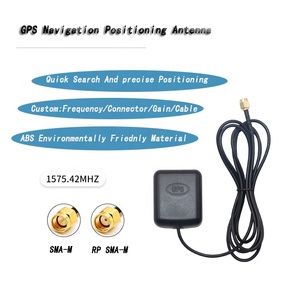(124 products available)







































































































































































 Ready to Ship
Ready to Ship
























































A Sat GPS tracker utilizes satellite technology to track and monitor the location of people, assets, and vehicles. The technology offers real-time tracking capabilities with global coverage. The devices come in different shapes and sizes to suit various applications. Here are the different types of satellite GPS trackers:
Frequency bands
Sat GPS trackers use various frequency bands to provide accurate location tracking. The most common frequency bands used by GPS trackers are L1 and L2. The L1 frequency band operates at 1575.42 MHz and is used by all GPS satellites. It is the most widely used frequency for civilian GPS receivers. The L2 frequency band operates at 1227.60 MHz and is primarily used for military and specialized applications. Some advanced Sat GPS trackers also utilize the L5 frequency, which operates at 1176.45 MHz and provides enhanced accuracy and reliability for critical applications.
Power source
Sat GPS trackers are powered by various power sources depending on the device's design and purpose. One of the most common power sources for GPS trackers is lithium-ion batteries. These rechargeable batteries offer long battery life and can be charged using USB or other methods. Some portable GPS trackers with lithium-ion batteries can last up to 24 hours on a single charge, making them suitable for tracking shipments or outdoor activities. In addition to lithium-ion batteries, some Sat GPS trackers use other battery technologies such as lithium-polymer or lithium-iron-phosphate batteries. These batteries may offer different performance characteristics, such as higher burst discharge rates for specific applications.
Data accuracy
Sat GPS trackers provide varying levels of data accuracy based on their design and the technology they employ. In general, GPS trackers offer location accuracy within a few meters to several meters, depending on the environmental conditions and the number of satellites in view. For example, handheld GPS trackers used for outdoor activities such as hiking or geocaching typically provide location accuracy within 5 to 10 meters. This level of accuracy is usually sufficient for recreational purposes and is acceptable for tracking vehicle movement during the weekend. On the other hand, specialized Sat GPS trackers used for applications such as surveying or asset tracking may provide location accuracy within 1 to 2 meters. These trackers utilize advanced techniques such as differential GPS or real-time kinematic (RTK) positioning to achieve higher accuracy.
Satellite communication
Some specialized GPS trackers can communicate with satellites in orbit to provide real-time location data, even in remote areas where traditional cellular networks may not be available. These specialized trackers utilize satellite communication technology to transmit location information to ground stations or receive commands from operators. By leveraging satellite communication, these trackers can maintain connectivity and ensure reliable tracking, regardless of the geographical location.
Size and weight
GPS trackers come in a variety of sizes and weights, depending on the device's purpose and the manufacturer's design considerations. For example, handheld GPS trackers designed for outdoor activities are typically compact and lightweight, weighing around 100 to 200 grams. This portability allows users to carry the devices comfortably while engaging in activities such as hiking, biking, or geocaching. On the other hand, vehicle GPS trackers installed in the vehicle's OBD-II port or attached to the vehicle's interior may be slightly larger. These trackers are designed to be compact and unobtrusive, measuring a few centimeters in length and width. Similarly, asset GPS trackers used for tracking shipments or monitoring the location of valuable goods during transportation are designed to be small and easily attached to the tracked assets.
There are many factors to consider when choosing the right GPS tracker for a particular use case. They include:
Coverage
When choosing a satellite GPS tracker, consider the coverage area first. Different trackers offer different coverage areas. Select a tracker that offers coverage for the areas the user intends to travel to.
Size and Weight
Consider the size and weight of the device being tracked. For tracking pets and kids, a smaller and lighter device is recommended. For vehicles, a heavier and larger device is acceptable.
Battery Life
Battery life is an important consideration when choosing a sat GPS tracker. A longer battery life is ideal for tracking a vehicle during a long road trip. A device with a short battery life is suitable for tracking pets or kids during a play date.
Real-time vs. Periodic Updates
Some satellite GPS trackers offer real-time updates while others offer periodic updates. Real-time updates are ideal for tracking vehicles during a road trip. Periodic updates are suitable for tracking pets or kids during a play date.
Durability
Consider the durability of the sat GPS tracker. For outdoor use, a durable and weather-resistant tracker is needed. For indoor use, a less durable tracker is acceptable.
Monthly Subscription Fee
Most satellite GPS trackers come with a monthly subscription fee. Consider the amount that can be afforded. Different trackers offer different subscription plans. Choose a tracker that fits the budget.
Additional Features
Consider any additional features that may be useful. Some satellite GPS trackers offer geofencing, SOS buttons, and speed alerts. Choose a tracker with features that are important for the intended use.
It is important to ensure that the proper steps are taken when replacing a Sat GPS tracker so that functionality is not lost. Here is a step-by-step guide on how to replace a sat gps tracker:
It is important to follow the steps carefully to ensure that the process is done successfully and the new device is functioning as it should.
Q1: How long does a sat GPS tracker battery last?
A1: Various aspects influence the lifespan of a sat GPS tracker battery. The sort of battery, its size, how often it's used, and the features it has all play a role. Typically, a sat GPS tracker battery can last from a few days to several weeks. Some have batteries that can last for a month or more if they are not used very much. It also depends on the kind of tracker. For example, those that track all the time use up the battery faster than those that track at certain times. While a long-lasting battery is helpful, users need to recharge or replace it after a given period to keep the device working.
Q2: Can a sat GPS tracker be used in any vehicle?
A2: A sat GPS tracker can be used in any vehicle as long as it is compatible with the vehicle's electrical system. However, for some people, installing a sat GPS tracker in a motorcycle or older vehicle may be more difficult. This is because these types of vehicles do not have a built-in onboard computer that can make it easier to install the device. But don't worry; there are other ways to install the sat GPS tracker in those kinds of vehicles. It can be done by using an external power source or different installation methods.
Q3: Is it legal to use a sat GPS tracker to track someone?
A3: Yes, it is legal to use a sat GPS tracker to track someone, but there are some rules that people need to follow. For example, in many countries, as long as the person being tracked knows about it and agrees to it, using a GPS tracker for tracking purposes is okay. But if someone tracks another person without letting them know or without their permission, that could break the law and be illegal. So, before using a sat GPS tracker to track someone, make sure to check the local laws and get the other person's agreement first.
The web search volume for the keyword "sat gps tracker" has shown a stable pattern over the past year with an average monthly web search volume of 10 queries. Despite this consistent figure, the data over the last twelve months reveals some interesting fluctuations. The web search volume peaked in February 2024 with 40 web searches and saw a notable increase in January 2024 with 30 web searches, contrasting sharply with the other months where it settled back to 10 web searches.
This trend indicates a seasonal variation in interest, particularly noticeable in the beginning of the year with spikes in January and February. The subsequent drop to the baseline web search volume of 10 in the following months suggests that these peaks are temporary anomalies rather than sustained increases in interest. The overall year-on-year and quarter-on-quarter changes remain at 0%, maintaining the keyword's position in the market without significant growth or decline.
The detailed analysis of monthly web searches for "sat gps tracker" highlights the importance of monitoring seasonal trends in web search volumes. Despite the keyword maintaining a steady average, the peaks at the beginning of the year suggest potential periods of increased consumer interest or market activity that could be leveraged for targeted marketing or product promotions. Understanding these patterns allows businesses to anticipate demand changes and adjust their strategies accordingly.